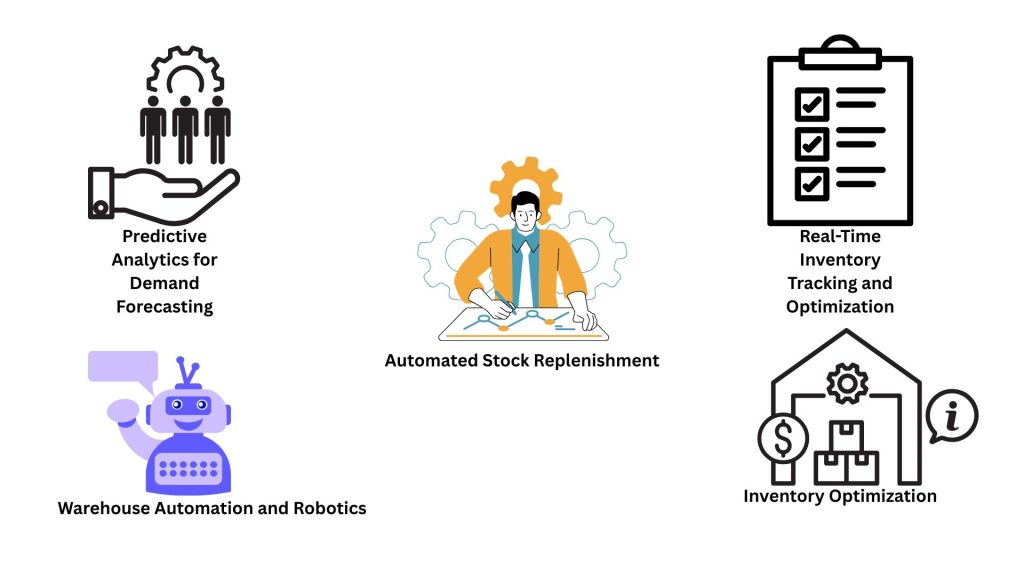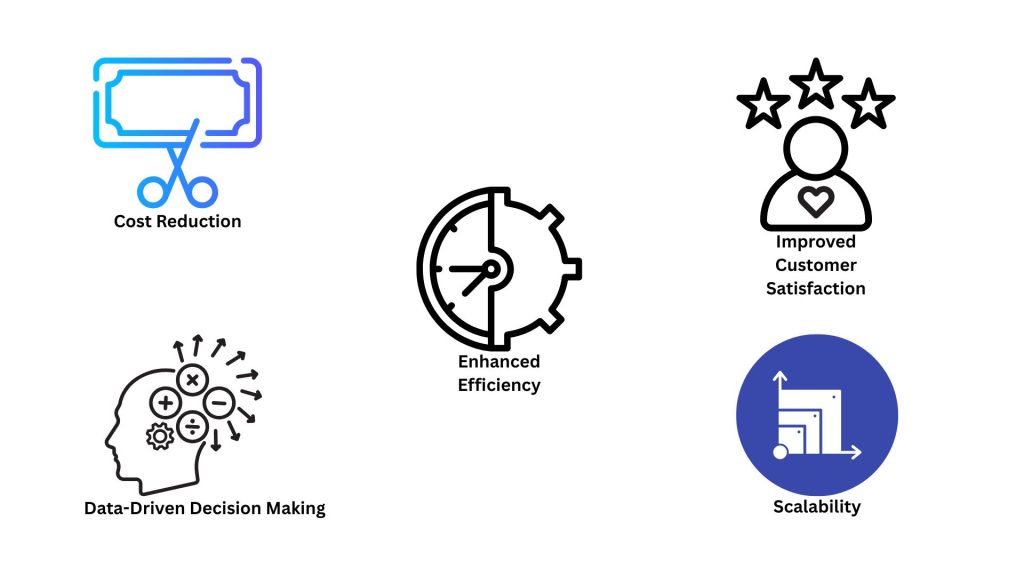The global supply chain landscape has witnessed significant disruptions in recent years due to events like the COVID-19 pandemic, trade wars, and geopolitical tensions. These disruptions have highlighted the fragility of traditional supply chains and have spurred many companies to rethink how they manage their operations. One area where this transformation is particularly evident is in inventory management. Traditionally, inventory management relied heavily on manual processes and human decision-making, leading to inefficiencies, stockouts, or overstocking. However, with the advent of artificial intelligence (AI), businesses now have a powerful tool to optimize their inventory management strategies, reduce costs, and improve customer satisfaction.
In this blog, we’ll explore how AI is revolutionizing inventory management and transforming the entire supply chain. We will discuss the key benefits, technologies, and real-world applications of AI in inventory management.
The Challenges in Traditional Inventory Management
Before diving into AI-powered solutions, it’s important to understand the challenges faced by traditional inventory management methods:
Forecasting Issues: Accurate demand forecasting is one of the most critical aspects of inventory management. However, relying on historical sales data and manual predictions often leads to inaccurate forecasts, resulting in stockouts or excess inventory.
Supply Chain Visibility: Traditional systems struggle to provide real-time visibility into inventory levels across different locations, making it difficult for businesses to track and manage their inventory efficiently.
Inefficiency and High Costs: Manual processes, like physical stock counts and human intervention in order processing, are time-consuming and prone to errors. These inefficiencies add unnecessary costs to the business and affect profitability.
Inventory Imbalances: Poor inventory management leads to imbalances in stock levels, with some products being overstocked while others face stockouts, which can impact sales and customer satisfaction.
With these challenges in mind, businesses are increasingly turning to AI-driven solutions to tackle these inefficiencies.
AI in Inventory Management: An Overview

Artificial intelligence, specifically machine learning (ML) and predictive analytics, has transformed the way companies manage their inventory. AI can analyze vast amounts of historical and real-time data to provide valuable insights into demand patterns, optimize stock levels, and improve overall supply chain operations.
Here are some of the key ways AI is being used in inventory management:
Predictive Analytics for Demand Forecasting: AI algorithms can analyze historical sales data, market trends, customer behavior, and even external factors like weather conditions or local events to forecast demand more accurately. By using machine learning, businesses can identify patterns that would be difficult or impossible for humans to detect.
For instance, AI can predict the demand for specific products based on seasonal trends, historical data, and even real-time changes in consumer behavior. With more accurate forecasting, businesses can optimize their stock levels, ensuring they don’t overstock or understock products. This leads to better cash flow management and reduces the costs associated with holding excess inventory.
Automated Stock Replenishment: AI systems can automate the stock replenishment process by continuously monitoring inventory levels in real time. When stock levels fall below a certain threshold, AI can trigger automatic orders to suppliers, ensuring that inventory is always at optimal levels.
Automated stock replenishment systems reduce the chances of stockouts and ensure that businesses can meet customer demand without excessive delays. By automating this process, companies can also reduce the risk of human error, which often leads to stockouts or over-ordering.
Real-time Inventory Tracking and Optimization: AI-powered systems can provide real-time visibility into inventory across multiple locations, warehouses, and distribution centers. This level of transparency allows businesses to track inventory movements, identify bottlenecks, and optimize the supply chain in real time.
Using sensors, RFID (Radio Frequency Identification) technology, and AI-driven software, companies can monitor their inventory and make data-driven decisions on stock allocation. For example, AI can recommend shifting inventory between locations to meet demand fluctuations, reducing the time spent on stockouts and excess stock.
Warehouse Automation and Robotics: AI is also being used to automate warehouse operations, making inventory management more efficient. Robotic systems equipped with AI can autonomously pick, sort, and pack products in warehouses, reducing human labor and the risk of errors. These robots work alongside AI-powered systems that monitor inventory levels, optimize the storage of products, and ensure accurate order fulfillment.
Moreover, AI-driven systems can predict the optimal placement of inventory in the warehouse, reducing the time it takes to locate and pick items. This not only speeds up the order fulfillment process but also reduces operational costs.
Inventory Optimization: AI-driven inventory optimization tools allow businesses to determine the optimal order quantities and reordering frequencies for each product. By analyzing historical data and current demand, AI can suggest the most cost-effective strategies for managing stock levels.
This process helps businesses avoid both stockouts and overstocking. By optimizing order quantities and replenishment cycles, AI enables businesses to reduce inventory holding costs while still ensuring products are available when needed.
Benefits of Leveraging AI in Inventory Management

Integrating AI into inventory management brings several significant benefits to businesses, including:
Cost Reduction:
By automating inventory management processes and improving forecasting accuracy, AI helps reduce operational costs associated with overstocking, stockouts, and manual processes. Businesses can reduce the amount of capital tied up in excess inventory, improving cash flow.
Enhanced Efficiency:
AI allows businesses to optimize their supply chains, automate routine tasks, and streamline inventory management workflows. With real-time data and automated processes, companies can reduce lead times, minimize delays, and improve order fulfillment.
Improved Customer Satisfaction:
Accurate demand forecasting, automated replenishment, and real-time inventory tracking ensure that businesses have the right products available at the right time. This reduces the chances of stockouts and backorders, which can frustrate customers and damage brand loyalty. Customers benefit from faster deliveries, better product availability, and an overall enhanced shopping experience.
Data-Driven Decision Making:
AI systems provide businesses with actionable insights by analyzing large volumes of data. Managers can use these insights to make more informed decisions about inventory, purchasing, and supply chain strategies. The result is a more agile and responsive supply chain that can adapt to changing market conditions.
Scalability:
As businesses grow, inventory management becomes increasingly complex. AI solutions can scale to meet the needs of expanding operations. Whether managing multiple warehouses, different product lines, or increased order volumes, AI can help businesses scale their inventory management processes seamlessly.
Real-World Applications of AI in Inventory Management
Several companies are already leveraging AI to transform their inventory management and supply chain operations. Here are a few notable examples:
Walmart: Walmart uses AI and machine learning to predict customer demand more accurately and optimize inventory levels across its vast network of stores and warehouses. The company has also adopted robotics and AI-driven systems to automate warehouse tasks and improve efficiency.
Amazon: Amazon’s AI-powered systems help manage its enormous inventory and streamline order fulfillment. The company uses machine learning for demand forecasting, optimizing product placement in warehouses, and automating inventory replenishment. Additionally, robots assist in sorting and moving products in its fulfillment centers.
Zara: Zara uses AI to manage its inventory across its global retail network. AI helps the company forecast demand, optimize stock levels, and automate reordering processes. This allows Zara to maintain efficient inventory turnover and ensure its stores are stocked with popular items.
Conclusion
The transformation of inventory management through AI is not just a trend but a necessity in today’s fast-paced, globalized market. By leveraging AI technologies like predictive analytics, real-time tracking, automation, and optimization, businesses can address the inefficiencies and challenges of traditional inventory management systems.
AI empowers businesses to make data-driven decisions, enhance operational efficiency, reduce costs, and improve customer satisfaction. As the supply chain landscape continues to evolve, those who embrace AI in inventory management will be better positioned to compete in an increasingly complex and competitive market.
Incorporating AI into your inventory management strategy could be the key to unlocking significant improvements in your supply chain – enhancing your ability to meet customer demand, reduce costs, and stay ahead of the competition.
So, if you do not want to fall behind the times and want to learn more about AI impacting your inventory then schedule a demo with one of our experts: https://pulllogic.com/contact/